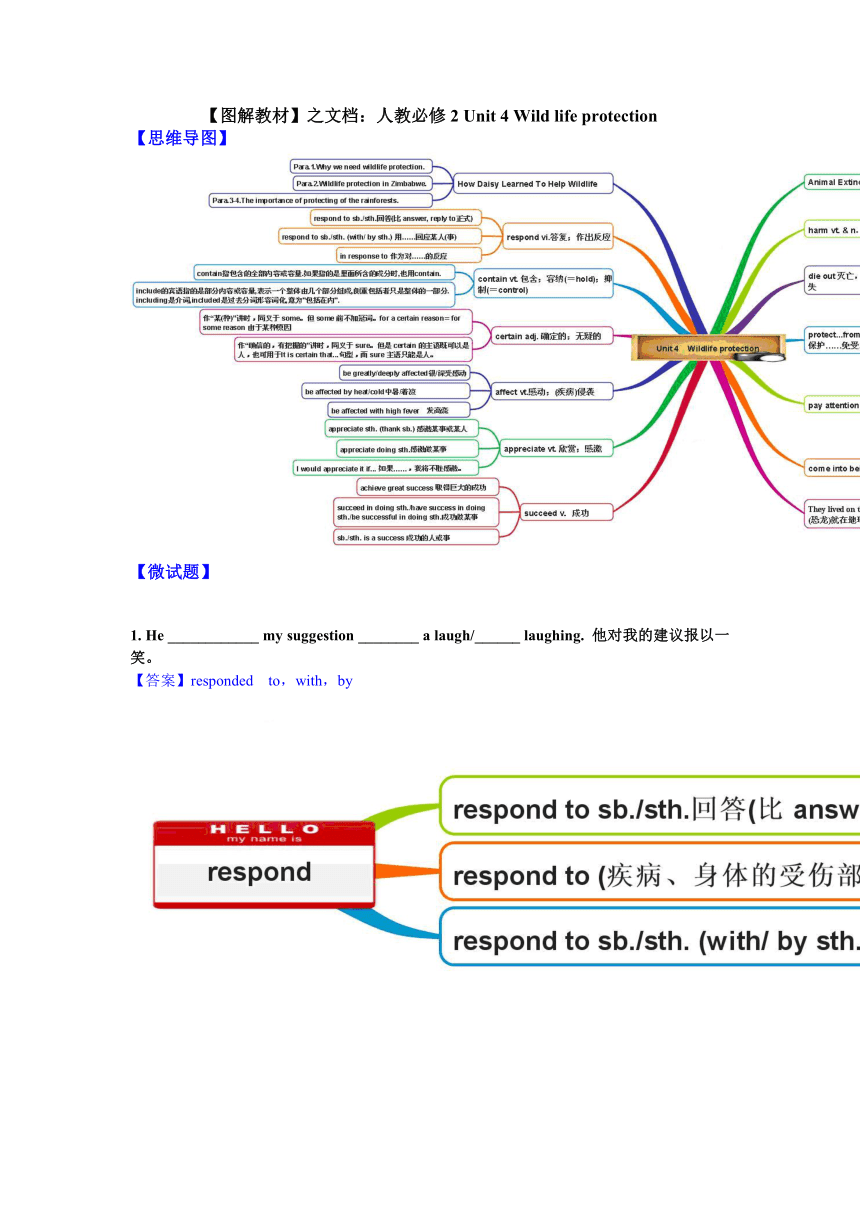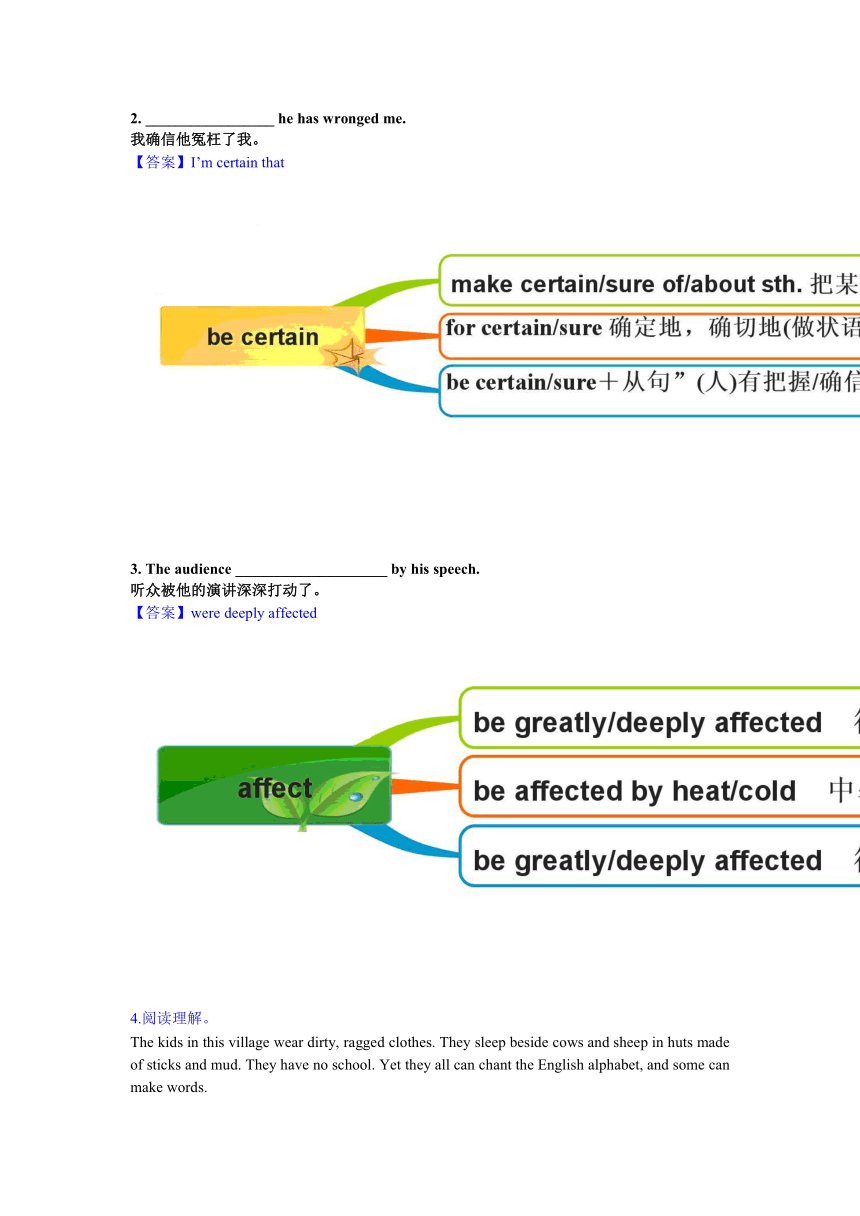图解教材(思维导图+微试题)人教高中英语必修2学案:Unit 4 Wild life protectionn
文档属性
| 名称 | 图解教材(思维导图+微试题)人教高中英语必修2学案:Unit 4 Wild life protectionn |  | |
| 格式 | zip | ||
| 文件大小 | 815.6KB | ||
| 资源类型 | 教案 | ||
| 版本资源 | 人教版(新课程标准) | ||
| 科目 | 英语 | ||
| 更新时间 | 2016-10-05 09:42:08 | ||
图片预览


文档简介
【图解教材】之文档:人教必修2
Unit
4
Wild
life
protection
【思维导图】
【微试题】
1.
He
____________
my
suggestion
________
a
laugh/______
laughing.
他对我的建议报以一笑。
【答案】responded
to,with,by
2.
_________________
he
has
wronged
me.
我确信他冤枉了我。
【答案】I’m
certain
that
3.
The
audience
____________________
by
his
speech.
听众被他的演讲深深打动了。
【答案】were
deeply
affected
4.阅读理解。
The
kids
in
this
village
wear
dirty,
ragged
clothes.
They
sleep
beside
cows
and
sheep
in
huts
made
of
sticks
and
mud.
They
have
no
school.
Yet
they
all
can
chant
the
English
alphabet,
and
some
can
make
words.
The
key
to
their
success:
20
tablet
computers(平板电脑)
dropped
off
in
their
Ethiopian
village
in
February
by
a
U.S.
group
called
One
Laptop
Per
Child.
21教育名师原创作品
The
goal
is
to
find
out
whether
kids
using
today’s
new
technology
can
teach
themselves
to
read
in
places
where
no
schools
or
teachers
exist.
The
Massachusetts
Institute
of
Technology
researchers
analyzing
the
project
data
say
they’re
already
amazed.
“What
I
think
has
already
happened
is
that
the
kids
have
already
learned
more
than
they
would
have
in
one
year
of
kindergarten,”
said
Matt
Keller,
who
runs
the
Ethiopia
program.
The
fastest
learner—and
the
first
to
turn
on
one
of
the
tablets—is
8-year-old
Kelbesa
Negusse.
The
device’s
camera
was
disabled
to
save
memory,
yet
within
weeks
Kelbesa
had
figured
out
its
workings
and
made
the
camera
work.
He
called
himself
a
lion,
a
marker
of
accomplishment
in
Ethiopia.
With
his
tablet,
Kelbasa
rearranged
the
letters
HSROE
into
one
of
the
many
English
animal
names
he
knows.
Then
he
spelled
words
on
his
own.
“Seven
months
ago
he
didn’t
know
any
English.
That’s
unbelievable,”
said
Keller.
The
project
aims
to
get
kids
to
a
stage
called
“deep
reading,”
where
they
can
read
to
learn.
It
won’t
be
in
Amharic,
Ethiopia’s
first
language,
but
in
English,
which
is
widely
seen
as
the
ticket
to
higher
paying
jobs.
1.
How
does
the
Ethiopia
program
benefit
the
kids
in
the
village
A.
It
trains
teachers
for
them.
B.
It
contributes
to
their
self-study.
C.
It
helps
raise
their
living
standards.
D.
It
provides
funds
for
building
schools.
2.
What
can
we
infer
from
Keller’s
words
in
Paragraph
3
A.
They
need
more
time
to
analyze
data.
B.
More
children
are
needed
for
the
research.
C.
He
is
confident
about
the
future
of
the
project.
D.
The
research
should
be
carried
out
in
kindergartens.
3.
It
amazed
Keller
that
with
the
tablet
Kelbesa
could
_______.
A.
learn
English
words
quickly.
B.
draw
pictures
of
animals.
C.
write
letters
to
researchers.
D.
make
phone
calls
to
his
friends.
4.
What
is
the
aim
of
the
project
A.
To
offer
Ethiopians
higher
paying
jobs.
B.
To
make
Amharic
widely
used
in
the
world.
C.
To
help
Ethiopian
kids
read
to
learn
in
English.
D.
To
assist
Ethiopians
in
learning
their
first
language.
【答案】1-4BCAC
【解析】介绍了一个使用平板电脑帮助非洲孩子阅读学习的项目。
(1).答案:B
解析:由第三段首句:The
goal
is
to
find
out
whether
kids
using
today’s
new
technology
can
teach
themselves
to
read
in
places
where
no
schools
or
teachers
exist.可知,这个项目有助于培养他们的自我学习能力。故答案选B.其他选项文中未涉及。【来源:21cnj
y.co
m】
(2).答案:C
解析:第三段第三行:What
I
think
has
already
happened
is
that
the
kids
have
already
learned
more
than
they
would
have
in
one
year
of
kindergarten.可知,他对这个项目的未来是乐观的,自信的。21cnjy.com
(3).答案:A
解析:由倒数第二段:Seven
months
ago
he
didn’t
know
any
English.
That’s
unbelievable.可知,Kelbesa
学习英语的速度是非常快的,故选A项。其他选项文中未提及。
(4).答案:C
解析:从文中最后一段首句:The
project
aims
to
get
kids
to
a
stage
called…where
they
can
read
to
learn.可知,答案为C项。A:为埃塞俄比亚人提供更高薪的工作;B:使Amharic语言在世界上更广泛的使用;D:帮助埃塞俄比亚人学习他们的第一语言;均不是此项目的目的。
Unit
4
Wild
life
protection
【思维导图】
【微试题】
1.
He
____________
my
suggestion
________
a
laugh/______
laughing.
他对我的建议报以一笑。
【答案】responded
to,with,by
2.
_________________
he
has
wronged
me.
我确信他冤枉了我。
【答案】I’m
certain
that
3.
The
audience
____________________
by
his
speech.
听众被他的演讲深深打动了。
【答案】were
deeply
affected
4.阅读理解。
The
kids
in
this
village
wear
dirty,
ragged
clothes.
They
sleep
beside
cows
and
sheep
in
huts
made
of
sticks
and
mud.
They
have
no
school.
Yet
they
all
can
chant
the
English
alphabet,
and
some
can
make
words.
The
key
to
their
success:
20
tablet
computers(平板电脑)
dropped
off
in
their
Ethiopian
village
in
February
by
a
U.S.
group
called
One
Laptop
Per
Child.
21教育名师原创作品
The
goal
is
to
find
out
whether
kids
using
today’s
new
technology
can
teach
themselves
to
read
in
places
where
no
schools
or
teachers
exist.
The
Massachusetts
Institute
of
Technology
researchers
analyzing
the
project
data
say
they’re
already
amazed.
“What
I
think
has
already
happened
is
that
the
kids
have
already
learned
more
than
they
would
have
in
one
year
of
kindergarten,”
said
Matt
Keller,
who
runs
the
Ethiopia
program.
The
fastest
learner—and
the
first
to
turn
on
one
of
the
tablets—is
8-year-old
Kelbesa
Negusse.
The
device’s
camera
was
disabled
to
save
memory,
yet
within
weeks
Kelbesa
had
figured
out
its
workings
and
made
the
camera
work.
He
called
himself
a
lion,
a
marker
of
accomplishment
in
Ethiopia.
With
his
tablet,
Kelbasa
rearranged
the
letters
HSROE
into
one
of
the
many
English
animal
names
he
knows.
Then
he
spelled
words
on
his
own.
“Seven
months
ago
he
didn’t
know
any
English.
That’s
unbelievable,”
said
Keller.
The
project
aims
to
get
kids
to
a
stage
called
“deep
reading,”
where
they
can
read
to
learn.
It
won’t
be
in
Amharic,
Ethiopia’s
first
language,
but
in
English,
which
is
widely
seen
as
the
ticket
to
higher
paying
jobs.
1.
How
does
the
Ethiopia
program
benefit
the
kids
in
the
village
A.
It
trains
teachers
for
them.
B.
It
contributes
to
their
self-study.
C.
It
helps
raise
their
living
standards.
D.
It
provides
funds
for
building
schools.
2.
What
can
we
infer
from
Keller’s
words
in
Paragraph
3
A.
They
need
more
time
to
analyze
data.
B.
More
children
are
needed
for
the
research.
C.
He
is
confident
about
the
future
of
the
project.
D.
The
research
should
be
carried
out
in
kindergartens.
3.
It
amazed
Keller
that
with
the
tablet
Kelbesa
could
_______.
A.
learn
English
words
quickly.
B.
draw
pictures
of
animals.
C.
write
letters
to
researchers.
D.
make
phone
calls
to
his
friends.
4.
What
is
the
aim
of
the
project
A.
To
offer
Ethiopians
higher
paying
jobs.
B.
To
make
Amharic
widely
used
in
the
world.
C.
To
help
Ethiopian
kids
read
to
learn
in
English.
D.
To
assist
Ethiopians
in
learning
their
first
language.
【答案】1-4BCAC
【解析】介绍了一个使用平板电脑帮助非洲孩子阅读学习的项目。
(1).答案:B
解析:由第三段首句:The
goal
is
to
find
out
whether
kids
using
today’s
new
technology
can
teach
themselves
to
read
in
places
where
no
schools
or
teachers
exist.可知,这个项目有助于培养他们的自我学习能力。故答案选B.其他选项文中未涉及。【来源:21cnj
y.co
m】
(2).答案:C
解析:第三段第三行:What
I
think
has
already
happened
is
that
the
kids
have
already
learned
more
than
they
would
have
in
one
year
of
kindergarten.可知,他对这个项目的未来是乐观的,自信的。21cnjy.com
(3).答案:A
解析:由倒数第二段:Seven
months
ago
he
didn’t
know
any
English.
That’s
unbelievable.可知,Kelbesa
学习英语的速度是非常快的,故选A项。其他选项文中未提及。
(4).答案:C
解析:从文中最后一段首句:The
project
aims
to
get
kids
to
a
stage
called…where
they
can
read
to
learn.可知,答案为C项。A:为埃塞俄比亚人提供更高薪的工作;B:使Amharic语言在世界上更广泛的使用;D:帮助埃塞俄比亚人学习他们的第一语言;均不是此项目的目的。
